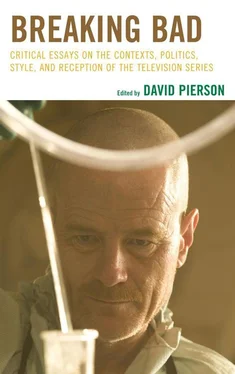In the end, the emergence of Heisenberg allows Walt to start over by creating a simultaneous second present, providing him with money he missed, power he gave up, and the credit that had been taken away from him. It also provides us with a glimpse into Walt’s true character that had been buried by various social constructs and external attitudes. All of this culminates into a hero cum villain that Nietzsche (1974) warns us about when he posits “Whoever is dissatisfied with himself is continually ready for revenge, and we other will be his victims” (290). Looking at Walt through a combination of Meadean, Deleuzian, and Nietzschean lenses might help us better understand how Walt transitions into a ruthless villain bent on obtaining control by deceiving Skyler, manipulating Jesse, watching Jane die, poisoning Brock, and murdering Gus and Mike. And, perhaps Skyler asking Walt “Is that you?” should be seen as much less about a man who faces his own mortality and more about a man attempting to recreate himself in the time he has left.
Even though Heisenberg is the most blatant multiple existence within Breaking Bad , other characters experiment with their own multiplicity. Jesse is known as Captain Cook, Gus is Gustavo in a former life. Walter Jr. is Flynn to differentiate himself from his father. Jesse’s friend Christian is Combo; Brandon is Badger. And, Skyler’s sister Marie assumes the names Torri, Charlotte, and Mimi. Each of these pseudonyms has a purpose to differentiate the established identity from the one being portrayed, but Marie’s assumption of other identities seems to be most similar to Walt’s need to reinvent himself. In one sense, a pseudonym allows Marie to absolve herself of thievery, placing the crime on a separate identity. However, the names also provide Marie with a life that is not her own, something that is most apparent in “Open House,” (7/31/11) when she passes herself off as a hand model with a former astronaut for a husband. She also pretends to be from London with a husband who’s an illustrator. Most intriguing about these most recent delusions is that Hank becomes a subject of her fiction as well, suggesting that Marie’s need for reconstruction is not exclusive to her person, but to everything that surrounds her. At the same time, her addiction to deception, shoplifting, and thievery build the foundation for a commentary on the prevalence of 12-step programs within Breaking Bad .
THE TIME CIRCUIT OF 12-STEP PROGRAMS
Though we never see Marie go to meetings, Hank alludes to them. However, Jesse, his ephemeral girlfriend Jane, Badger, and Skinny Pete all enter and exit 12-step programs repeatedly for their addictions. Admittedly, the connection between these programs and the anxiety over time that has been discussed throughout this project might not be clear. However, if we look at the programs metaphorically through a Freudian lens, it becomes clear the programs into which each character enters becomes a circuit of failure that ultimately correlates to varying amounts of time lost in futilely reinventing one’s self. Freud (1920), in his psychoanalytical theory, looks at ladders, ascents, and steps, suggesting “that they have the rhythm of walking as a common characteristic; perhaps, too, the heightening of excitement and the shortening of breath, the higher one mounts” (loc 2126). Admittedly, Freud is discussing dreams, but in the same way that steps in a dream signify fulfillment, completing the steps within Breaking Bad equal the fulfillment of becoming clean. However, like gym-goers on a Stair Master, the characters within the series never reach the final step, consistently relapsing and starting over in a perpetual, time-sucking circuit. On the one hand, this might speak to an inability to change—something that would also support the notion that Walt has always been Heisenberg in disguise. On the other hand, these steps also relate to the convergence of past, present and future. The past and its memories bring the addicts to their present decision to change their lives, which, theoretically, provides them with the desired future. Considering the dangers of methamphetamines and heroin, climbing these steps builds a surplus of time for the future that—if they remain addicts—would most probably be depleted. The problem inherent in this circuit is that future time is wasted because the surplus becomes occupied by the characters’ repetition of the same steps in order to reach the final one. The past and their past drug use continue to haunt their present (attempts in the program) and disrupts their intended future (living habit-free), thus creating a veritable time suck.
The occurrence of addiction and treatment within the narrative is a central theme, and the attention paid to addiction in seasons two and three suggests that Vince Gilligan has no intention to write them off as mere twists and turns. “Grilled” (3/15/09) marks the first reference to a 12-step program (Marie’s). This season also introduces us to Jane, Jesse’s girlfriend and landlord, a former heroin addict working her way through recovery. A number of conflicts ensue on account of Jesse’s line of work and Jane’s sobriety, but most intriguing is that Jane relapses during “Phoenix” (5/24/09)—the twelfth episode—signifying a fracture in her steps, a symbolic inability to complete the twelfth step, and entry into the aforementioned circuit of failure. Her eighteen months spent in sobriety and the trust she rebuilt with her father is painfully obviated and neatly euphemized as a ‘backslide.’ Season three begins in a similar fashion as we encounter Jesse in media res of his 12-step program, clean for forty-five days and proudly displaying the coin from this rearview mirror as he drives his car. This in and of itself is a visual symbol of the past, present, and future converging at one time: Jesse’s forward motion (driving toward his destination) is simultaneously depicted with his present state of sobriety (forty-five days) as the travelled-on road (past) disappears in the mirror. However, by the end of the third season, Jesse, too, backslides in “Half Measures” (6/6/10)—the twelfth episode.
The occurrence of both relapses in a twelfth episode can hardly be coincidence. Rather, it’s a way of demarcating time lost during each season. Through eleven episodes, Gilligan exhibits struggling characters to root for. As Walt makes his journey closer to being an anti-hero, Jane provides us with hope for Jesse, while Jesse in season three fuels an additional hope that he might put himself on the straight and narrow. However, both of these scenarios come to a crashing halt. Unfortunately for both Jane and Jesse, their efforts are all for naught. In both situations, the time spent in programs and sobriety is wasted; concurrently, their choices result in unintended action—Jane asphyxiates on her own vomit; Jesse fails to kill the two men. Thus, their attempts are similarly thwarted, and they remain caught in a circuit of failure.
Jane’s death compels Jesse to enter rehab, but it also triggers an emotional decline that shifts his desire for fat stacks of cash into indifference. This creates a marked juxtaposition with Walter, who transitions from a man with dwindling time attempting to recover lost time into a man living on borrowed time. This “borrowed time” further allows Walt to become Heisenberg and marks a shift in the trajectory of his persona. Throughout the first two-thirds of the second season, Walt’s cough becomes more prominent, and accompanied by blood, encouraging him to spend his spare time cooking enough meth to generate over half-a-million dollars as his share of the profits. This weekend of meth cooking occurs in the appropriately titled “4 Days Out.” As Walt believes he is on the verge of death, these four days become the time allotted to recoup all lost time, meaning that Walt is essentially buying time for his family with his days in the New Mexico prairie. However, for this discussion, the importance of this episode is its closing scene in the oncologist’s office, where Walt learns that his cancer has gone into remission. Regarding the prognosis, the doctor emphasizes that they’re not out of the woods yet, but still have some options including more time. The doctor’s response highlights the importance of the time that Walter has left, and in this moment, the time spoken of shifts from dwindling and fleeting to borrowed , and similarly signifies a rebirth. This interpretation can be garnered from Walt’s prognosis, but also from separate moment that involves Skyler’s visit to her OB/GYN within the same episode. The moment is brief, but her doctor notes that the baby is fine and will arrive according to plan, in its own time. In one sense, the gestating child is the antithesis of Walter’s ostensible decline in the prairie; however, its inevitable arrival parallels Walter’s rebirth upon hearing his prognosis.
Читать дальше












